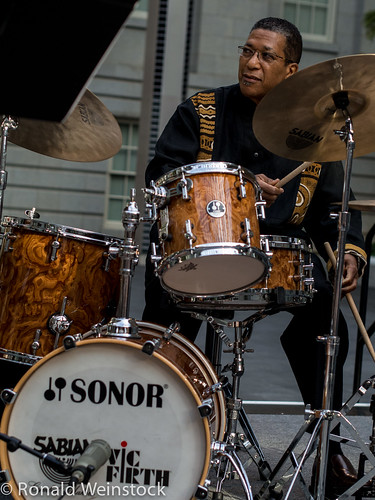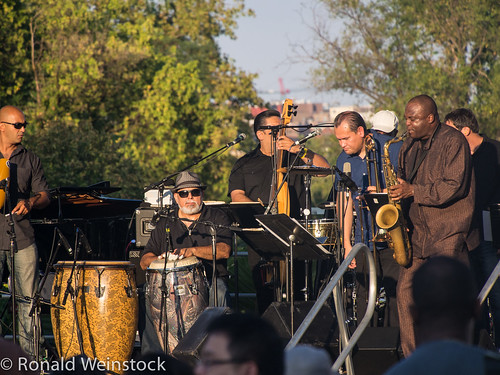 |
| Hamid Drake - Artist in Residence at the 2013 Chicago Jazz Festival |
Circumstances led me to Chicago this past Labor Day weekend where I had the opportunity to sample the 35th Annual Chicago Jazz Festival. This was my first time at this event which was for the first time in Chicago’s Millennium Park. In prior years it had been in Grant Park, which is where the fabled Chicago Blues Festival is still held. This festival, while having several performance stages, attracts smaller audiences than the June Blues Fest, which I understand was one reason for the change. The festival is curated by the Jazz Institute of Chicago which also produces and programs other concerts and events and produced by the City of Chicago.
During the daytime, there are two substantial tent stages that house performances (The Jazz & Heritage Pavilion and the Von Freeman Pavilion) with the evening headline performances featured in the Jay Pritzer Pavilion, a marvelous facility with several thousand seats and then plenty of lawn seating. There were a variety of events including a solo piano concert series that took place prior to the main Festival kickoff. On the main festival site, Chicago Jazz Magazine operated a CD tent
There was plenty of music to be heard covering a range from traditional styled Chicago jazz to hard bop and to free jazz. Drummer-percussionist Hamid Drake was the Artist in Residence and was heard in four different settings. I heard a fair amount of music as well as did not get to hear some acts that I would have liked to but whether and other factors prevented, so I have provided just some few observations of the performers that stood out to me.
 |
| Fat Babies at the Chicago Cultural Center |
Fat Babies is a traditional band playing in what may be called Chicago style. Influenced by King Oliver, the Austin High Gang and Jelly Roll Morton, this band played crisply and delightfully in this older style of jazz at the Chicago Cultural Center . High points of their set included King Oliver’s “Snake Rag, Eddie Condon’s Sugar, and Jelly Roll Morton’s The Crave. They have assimilated the style of twenties jazz well that even originals come across as songs from that era.
Jack DeJohnette’s Special Legacy Edition Chicago was a special band assembled to celebrate the great drummer-composer and bandleader’s career. With Thursday, August 29 declared by the Mayor Jack DeJohnette Day in Chicago, he brought together legendary Chicago figures pianist Muhal Richard Abrams and multi-instrumentalists Roscoe Gordon and Henry Threadgill. These three, all associated with the AACM all played roles in DeJohnette’s musical development. Bassist Larry Gray completed this group with the ensemble playing a composition by each of the members. The music was demanding and free with a mix of fervor and abstraction in the performance. Compositions by Abrams and DeJohnette struck this listener as the most realized performances and Abrams was especially impressive throughout as was the leader. This performance was professionally recorded so those of you who were not at this performance will have a chance to hear it at some point.
 |
George Freeman played at the dedication of the
stage dedicated to the memory of his brother Von |
Guitarist George Freeman was part of the Friday celebration of his late brother Von for whom a stage was dedicated at the Festival. George is perhaps the last living Chicago jazz musician to have played with Charlie Parker. He displayed his considerable chops on an unaccompanied guitar instrumental. He was followed by a band led by saxophonist Christopher McBride for a set of hard bop infused music. I should mention that heavy rain early Friday evening led me to miss Wadada Leo Smith’s performance of selections from his Ten Freedom Summers. Of the performances I did not attend, this was probably the one I missed the most.
Having heard about saxophonist Ernie Krivda for so long and having enjoyed his recordings, I really enjoyed seeing him perform. With a robust attack and a fine band, he would be well better known of he had not chosen to stay in Cleveland. I remember bassist Stafford James from seeing the Louis Hayes-Woody Shaw band in 1976. Having returned from Europe in the past few years, James led a String and Percussion ensemble that included a string quartet, a reed player and M’Boom, the percussion ensemble the late Max Roach founded. While James played arco throughout, his mentor Richard Davis was also part of this fascinating ensemble. James’ compositions and the ensemble’s execution of the arrangements was a fresh listen.
 |
| Gregory Porter and is Great Band |
Gregory Porter followed and was spectacular. This was my second time to see him live and the first with his exceptional band. His rich voice with echoes of Donny hathaway and Marvin Gaye, his marvelous original material and his ability to tell stories with his voice were enthusiastically received. He previewed a couple songs from his forthcoming Blue Note recording along with rousing renditions of Painted On Campus, On My Way To Harlem, Be Good, Nat Adderly’s Work Song and 1960 What? He is probably my favorite male vocalist in any genre now. He is that good!
 |
| Fast Citizens |
Having been impressed by the most recent recording by the post-Ornette group, Fast Citizens, I was impressed by their live performance that exhibited the same mix of composition, improvised playing and empathetic ensemble playing that made that recording so memorable. Saxophonist and Juli Wood gave a standout performance with her robust sax playing and her strong singing backed by some fine players. I enjoyed her so much that I purchased her CD.
 |
| Evan Christopher on clarinet and Don Vappie on guitar |
Evan Christopher also delights with his clarinet playing as reflected by the fact he was a finalist in the Jazz Journalists Associations Voting. He brought an exceptional quartet of Don Vappie on guitar and standup bass (Vappie is usually associated with the banjo), keyboardist Joe Alpher and drummer Ocie Davis, that provided bright interpretations of songs associated with Duke Ellington (Alex Hill’s Delta Bound) and originals including a number inspired by the creole traditions in Haiti as well and his own boogie woogie number. He received a particularly warm reception from the Von Freeman Pavilion audience.
 |
| Hamid Drake, Joshua Abrams, Jeff Parker and Jason Adasiewicz |
The final act I wish to highlight was Hamid Drake & Bindu: Reggaeology. Hamid Drake, a drummer and percussionist of note, was the Festival’s Artist in Residence and while his other Festival shows were likely more in the manner of free jazz, Reggaeology was notable for his mix of groove and lively musical textures and colors that likely made this performance more accessible to more casual listeners. His ensemble included trombonists Jeb Bishop and Jeff Albert, guitarist Jeff Parker, bassist Joshua Abrams, vibraphonist Jason Adasiewicz and vocals and beat box by Napoleon Maddox. The performance reprised his 2010 recording (Rogue Art) and all of the persons on that recording were present with the addition of Adasiewicz who provided a solo voice in addition to Parker, Bishop and Albert as Drake was marvelous in his roles as composer, leader and drummer.
This was ann uusual Jazz Festival that included a significant amount of free jazz m ixed with more mainstream, straight-ahead offerings. The sound was quite good, especially in the Pritzer Pavilion. With a heavy dose of exceptional local talent mixed with its internationally know headliners, the Chicago Jazz Festival was part of a vacation that I ended my summer on a high note.
These informal comments were written for Jazz & Blues Report.






























